In the last chapter of our guide series on how to build an eCommerce website from scratch, we covered eCommerce payment solutions. Assuming you’re done picking the relevant payment service, let’s get into shipping and how little strategies can help bubble up against its complexities. In the given chapter, we’ll learn how to calculate shipping costs for online store.
Ask us! We have come across many brands that are clueless about their shipping strategies.
- They’re not sure if they should charge their customers or not.
- Or should they add fees to their products?
- In fact, they don’t even know how much they need to add.
Result? Net loss (and net mess)!
And if you dislike Math, you’re only going to axe your legs. Unfortunately, all the shipping strategy answers are based on calculating the shipping cost first. But fortunately, we are happy to help.
This chapter will include the following:
- Things You Need To Calculate Shipping Costs
- Steps To Calculate Shipping Costs For Small Businesses
- Step 1: Analyze All Your Products
- Step 2: Finalize The Packaging Option
- Step 3: Calculate The Weight Of The Product (With Package)
- Step 4: Calculate The Package Dimensions
- Step 5: Calculate The Cost Of Packaging Materials
- Step 6: Find The Shipping Provider/Shipping Carrier
- Step 7: Determine The Shipping Slabs
- Step 8: Use Online Shipping Cost Calculator
- Step 9: Compare the shipping agents’
- Shipping Strategy
- Shipping Strategy #1: Cost Of Shipping Is Never Free
- Shipping Strategy #2: Solve The Free Shipping Conundrum
- Shipping Strategy #3: Calculate & Apply The Free Shipping Threshold Gimmick
- Shipping Strategy #4: Set Different Inventory Pricing
- Shipping Strategy #5: Base Level Strategy
- Shipping Strategy #6: Offer Live Rates/Real-Time Carrier Rates
- Shipping Strategy #7: Offer Table Rates
- Shipping Strategy #8: Offer Flat Rate Shipping
- Shipping Strategy #9: Combine several shipping options
- Shipping Strategy #10: Use Shipping Brokers
- Shipping Strategy #11: Free In-Store Pickup
- Shipping Strategy #12: Packing Peanuts
- Shipping Strategy #13: Fulfillment Partners
- Conclusion
Things You Need To Calculate Shipping Costs
These are absolute musts to calculate shipping costs for your products.
Weight scales
- Digital kitchen scales: You need kitchen scales to measure small products weighing between 0.05 ounces and 12 pounds.

- Traditional scales: Use traditional scales to measure anything big and heavy.

Dimension Tape
Some shipping companies charge you based on dimensions. So you want to know the size of your package. Get a dimension tape to measure their sides.

Calculator
A simple cost calculator would do. You don’t need a scientific calculator for it.

Template
It’s best to have an excel template to keep records of products, packaging dimensions, weight, and price. Not very tough. We have created one. You can create yours and also include the fields you need.

Steps To Calculate Shipping Costs For Small Businesses
Assuming you are good with all the equipment, let’s begin calculating the shipping cost for your small business.
Step 1: Analyze All Your Products
So the first step is to be aware of the products you want to ship. This means what you are going to wrap. Let’s take, for example, you sell Mouses and Keyboards and want to ship them.


Now let’s get back to the template we prepared and start populating it. Ohh! Also, we have a way out for you if you can’t think of SKUs.
Go to the SKU Generator >> Fill item name and attributes >> Add

Here’s how the table looks.
Step 2: Finalize The Packaging Option
Once you know your product in and out and what you’re going to wrap, it’s time for you to finalize the packaging options.
So there are many packaging options. Depending on what you’re selling will determine the packaging.
- Box/Rigid Packaging

- Envelope

- Padded Envelope

Source: Walmart
- Biodegradable Poly Mailers

Source: Alibaba
- Crinkle Sheds (for the safety of fragile items)

Source: Amazon
- Biodegradable Peanuts (for the safety of fragile items)

So these are the packaging options you’ve got. You can also check out the shipping companies’ websites. They offer different types of packaging solutions.
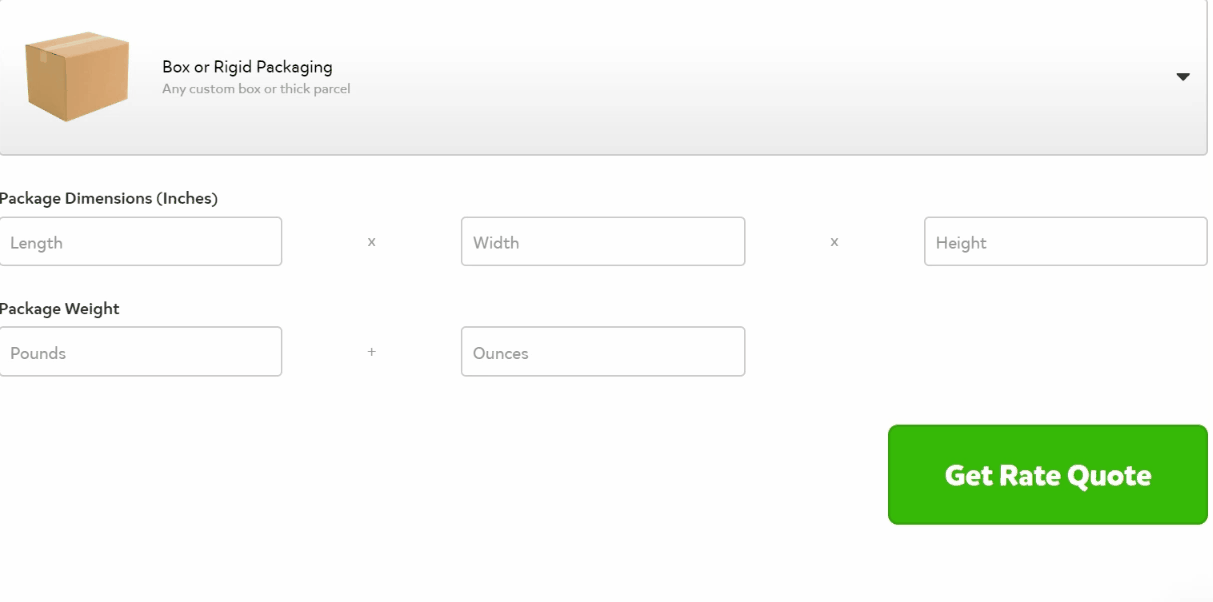
For Customized Packaging
We have one brand experience solution for customized packaging. Arka. They let you design your packages and place orders with them.

Source: Arka Design
Also, the boxes are optimized for shipping rates. So you don’t have to worry about the extra costs.

Arka also allows custom branding labels and stickers.

In the current case, we are shipping a mouse and keyboard. So it’s a no-brainer, corrugated boxes are suitable for them.


Fill in the packaging option in the sheet.

Also, you will have to order boxes that could fit your products. You can always select the boxes by selecting the ideal size dimension.

Step 3: Calculate The Weight Of The Product (With Package)
Now that the packages have come, give the products complete packaging (the way you will deliver them). Put the fillers in. Thank you notes. Ribbons. Labels. And everything you want on the package.
Once your package is ready, put it on the weight scale.

Source: Walmart

Step 4: Calculate The Package Dimensions
Though you’ve ordered boxes based on dimensions, it’s good to verify them again. You’re doing it this time for the shipping companies.
Use dimension tape to measure the package’s length, breadth, and height and note them in the template.

Some shipping carriers may charge based on dimensional weight, and others on volumetric systems.
You can also add a column for package volume in the template. We haven’t.


Step 5: Calculate The Cost Of Packaging Materials
Now you want to calculate everything you used for packaging. People are constantly losing money on this because they don’t add the cost of basic things like thank-you notes and ribbons.
Here’re other things you can add to the packaging.
- Wrapper

- Fillers

- Thank You Note

Source: Etsy
- Ribbon

- Bubble wraps

Source: Amazon
Labels

Source: Arka Labels
Since we are shipping a Mouse and Keyboard, you can use bubble wrap for an extra layer of safety.
Now add the cost of the box and accessories.
Packaging Cost: Cost Of Box + Cost Of Accessories
Check out another template to keep records of your cost.

Step 6: Find The Shipping Provider/Shipping Carrier

Source: Clickpost
The next step is choosing the best shipping carrier. It’s hard to know the right option, mainly when hundreds exist. But we have created some criteria to filter out the best shipping providers.
Criteria #1: Do they deliver your products?
Okay, so this is where you begin. You want to go with the shipping carriers who deliver the type of products you’re selling. Many services exclude expensive and fragile items.
It’s easy to find it. Go to Google and search “FedEx excluded product list or FedEx restricted list items.”
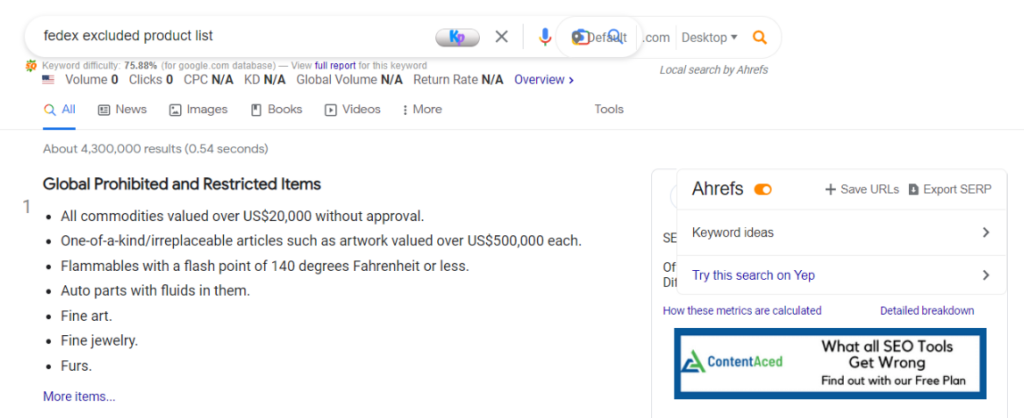
Click on the relevant link from FedEx.

Find your product in the list

If your product is on the list, they don’t deliver it. You would need to hop onto another carrier. If you’re selling multiple items, it may be possible for some carriers to deliver some of the products and not others.
In that case, you have to recognize which carrier delivers what products.
Criteria #2: Are shipping locations available?
You want to check three things here.
- First, do they have a drop-off location in your area? It determines if you have a nearby location to drop off your package.

- Second, do the carriers ship to the country you want to? You can do this by checking the store locator on their websites. Once they operate in your preferred country, you can find out whether they deliver to the locality.

- Third, do they ship to the local areas? It’s a way of finding out if they deliver to the exact visitor’s location.
You also want to check what kind of tracking services they offer. Is it a free untracked service? Is it a paid tracking service?
Criteria #3: Is SHIPPING insurance available?
Insurance is another criterion you want to check, especially while shipping expensive items globally. Again, most shippers provide insurance information on their websites. Just in case you don’t want to go over and over again, copy the insurance values in your template.

You can refer to the insurance costs every time you place a shipment.
Criteria #4: Is the carrier convenient?
We mentioned in the first criterion to look for drop-off locations. But give first preference to carriers offering personalized pick-ups from your location and drop-offs when needed. It ensures pick-up convenience for any order.
Criteria #5: Is the carrier budgeted?
Finally, compare the prices and services. It’s no rocket science. Compare the prices for each carrier and go with the ones with the optimized pricing and services.
Step 7: Determine The Shipping Slabs
The next step is determining the shipping type your carrier provides and what you expect from them. If you have multiple shipping strategies on your eCommerce store, you’d want to go with the carriers that offer multiple services like:
- Free Shipping (offer free shipping, but also no tracking details)
- Standard Shipping (the shipping with standard delivery date and tracking)
- Premium Shipping (fast shipping with tracking details)
You also decide the levels of shipping in this step. It means how many shipping ways you want to have domestically and internationally. We generally recommend having:
- Three shipping slabs for domestic orders
- One-day delivery
- Free shipping
- Standard shipping
- Two shipping slabs for international orders
- Standard shipping
- Express shipping
Step 8: Use Online Shipping Cost Calculator
Almost all the carriers will have an online shipping calculator to the location you want to ship. The calculation initially gives you the ballpark figure, so you know the strategy you need to apply. Here’s an example of FedEx shipping costs calculation:
- Fill in the origin and destination details

- Now fill in other details like package weight and delivery date

- Click on show rates

You can repeat the process for all the carriers and compare the prices manually. And as always, never be hesitant to create a sheet.
Step 9: Compare the shipping agents’
We compared shipping carriers in the sixth step. But here’s one step we missed, i.e., finding the balance between time efficiency and cost efficiency.
A lot of carriers are quick to deliver but are super expensive. The other ones are cost-effective but are super slow!
The real complexity lies in finding the balance between the two. We’ll show you one of the examples we practice using Pirate Ship to find the balance. Here’s how you can do it.
- Go to Pirate Ship and create your account.
- Now you want to fill in the details like types of packaging, dimensions, weight, and Zip code.

Here’s how it looks

- Select the packaging type

- Hit on Get Rate Quote

So here are the options for you. You have an estimated delivery date. You have estimated the cost. Plus, little nitty-gritty like insurance, savings, and tracking offers.
We also calculated the shipping costs of keyboards on the USPS shipping calculator. Here’s what we got!

Look at the table. The comparison table helped us decide whether to go with priority mail express or flat rate boxes or pick from five other options. You can apply the same comparison tables to your products and find the balance between time and cost. 🙂
Well, that’s all about calculating shipping costs. But one thing that’s worth noticing is no shipping calculation will help if you don’t have strategies in place.
You may apply all the math to calculate the shipping fees, but if you don’t solve the free shipping conundrum, base-level strategies, and other uncalled-for problems, you’ll only regret it. But we have made sure you won’t regret it. We’re also going to cover shipping strategies.
Shipping Strategy
The best shipping advice we can start with is…
Shipping Strategy #1: Cost Of Shipping Is Never Free
Shipping is never going to be free. You may want to be generous to your customers. You find out your competitors are offering free shipping. But they’re not. Someone has to pay for it. The three shipping approaches would be:
- Add the shipping price on the product: customers pay

- Bear full shipping price: you pay

- Add a part of the price on the product: customers & you pay
If the delivery charge costs 10$, add a part of it to the product and make shipping free.
Shipping Strategy #2: Solve The Free Shipping Conundrum
90% of online visitors would shop from stores having free shipping options, and free shipping & return cost billions in the supply chain.
Contrary stats. What should you do in such a case?
Free shipping services are the biggest nightmare for most online retailers. You can solve the problem by determining the shipping cost for all the classes. Let’s apply the example on our keyboards.
- Find the original shipping cost
Let’s say UPS shipping costs for the keyboard are as follows.
- Untracked shipping 5$
- Tracked shipping 10$
- Express shipping 15$
- Now spot the shipping with the lowest price
In this case, untracked shipping worth 5$ is the cheapest.
- Reduce that amount from all the classes
So the new shipping cost
- Untracked shipping 5$- 5$ = 0$
- Tracked shipping 10$-5$ = 5$
- Express shipping 15$-5$ = 10$
- Add the same amount to the product
New Cost Of Product = The Old Cost Of The product + The Cost of Untracked Shipping
In the case of keyboard and mouse
- New cost of keyboard = 50$ + 5$ = 55$
- New cost of mouse = 30$ + 5$ = 35$
This is what you have to display at your checkout with free shipping.
At this point, no matter what type of shipping class your visitors choose, you have given them the most crucial class: free shipping (without losing money).
Shipping Strategy #3: Calculate & Apply The Free Shipping Threshold Gimmick
The last method we mentioned is the absolute least strategy you can apply. But this one is for more accuracy. Apply free shipping threshold marketing. But it only makes sense when you know the threshold value.
Now what is the free shipping threshold?
Free shipping threshold is a marketing tactic wherein you put a free shipping bait for multiple purchases, thereby increasing average order value. To make the marketing efforts successful, you set the threshold value. But the problem with the free shipping threshold is you can’t set an arbitrary value. Here’s why an arbitrary free shipping threshold is not recommended.
- If your average order value is 100$ and you set free shipping at 700$, it may not make sense to customers as they may not have such a huge appetite. So they may never enjoy free shipping offers.
- By the same token, if your average order value is 100$ and you set the minimum buy for free shipping as 85$, you’re taking a massive blow.
That’s where a little math can save you.
Here’s how you can calculate your free shipping threshold.
- Step 1: Determine your average order value. You can find the value from your Google Analytics data. (example: 100$)
- Step 2: Calculate your average shipping costs. All shipping prices/number of distinct shipping made. (example, 20$)
- Step 3: The next step is to find out the Gross profit and gross profit margin. You can calculate Gross profit by subtracting the total cost of producing the product from the total sales you made. (for example, the total sale is $250k and cost of production is 150k$). So the gross profit would be ($250k-150k$) = $100k. Also, the gross profit margin would be gross profit/total sales. ($100,000/$250,000) = 40%
- Step 4: Put forward a minimum cart value (try to be close to the minimum order value. For example, 112.5$)
Now let’s test whether our proposed minimum cart value makes sense.
- Subtract average order value from proposed minimum cart value (112.5$ -100$ = 12.5$)
- Multiply the difference by gross profit margin (12.5$ * 0.40 = 5$)
- Subtract the multiplication from the Average Shipping Value ($20-$5 = 15$)
You can observe if you set 112.5$ as the minimum cart value, you’ll have to pay 15$ for every qualified order. The amount may take a massive toll on your profit. Now let’s try again! Let’s propose a new minimum cart value. Let’s keep it 137.5$
Follow the same structure.
- Subtract average order value from proposed minimum cart value (137.5$ -100$ = 37.5$)
- Multiply the difference by gross profit margin (37.5$ * 0.40 = 15$)
- Subtract the multiplication from the Average Shipping Value ($20-$15 = 5$)
So you only upped your threshold by about 25$ and dropped your shipping cost by 10$. That’s much more gettable. Right?
Shipping Strategy #4: Set Different Inventory Pricing
If you ship domestically and internationally, it’s better to have different pricing in the backend.
Inventory pricing helps you set different prices for both. Most eCommerce platforms like Shopify and WooCommerce let you assign different domestic and international pricing values in the backend. It means international and domestic users will see different pricings set by you.
Shipping Strategy #5: Base Level Strategy
Remember we told you in strategy #1 that shipping is never free? But you can have something like sharing the shipping burden with customers.
That’s base level strategy. Here you break the shipping cost in half or any relevant figure and add it to the product making the shipping cost look cheaper.
Look! This is not something that you can’t scrap once tried. You can always go back to the old strategies or devise new ones if it doesn’t work. For example, if the shipping price is competitive, no matter how much burden you share with the customers, you may never be successful in pleasing them.
Shipping Strategy #6: Offer Live Rates/Real-Time Carrier Rates

If you don’t want to risk shipping miscalculation, many shipping carriers let users calculate real-time carrier rates at checkouts. This prevents you from two things:
- you’re not setting any shipping values only to have losses in the end
- you get rid of all the shipping strategies
Real-time carrier shipping is when an eCommerce checkout automatically pulls over the exact shipping rates for any order at any location. Now how do you implement it?
Shipping carriers such as FedEx and USPS have real-time shipping extensions that display live rates at checkouts. For example, the FedEx extension calculates shipping quotes worldwide for these services. All you have to do is integrate the extension with your store.

Useful resources
Shipping Strategy #7: Offer Table Rates
The table rates shipping strategy is the strategy that lets you set rules and conditions to determine the shipping cost for any order. For example, weight! It’s a condition that increases the shipping price as it goes up. So you set the table rules and conditions for weight like
- 1-5 lbs: $10
- 5-10 lbs: $14
- 10-20 lbs: $20
It seems pretty simple, right? You can set more complex rules with table rate shipping. The rules are in your hand. You can write rules like:
- Add 5$ to shipping costs for any item between 1 lb to 5 lbs
- Subtract 3$ if the cart has three products
- Make shipping accessible if the average order value crosses 500$
You can then prioritize your rules and let one override the other if needed.
Check out this great documentation on table rate.
Shipping Strategy #8: Offer Flat Rate Shipping
Flat rate shipping is another popular option wherein you charge the same for all the products in the store. But you have to take care of two things:
- the strategy only works for the product lines with the similar weight and sizes
- make sure you’re not over or undercharging users
Here’s an example of flat rate shipping


Product two costs almost thrice as the first one. But the shipping cost stays standard. That’s flat-rate shipping. The brand could pull out the strategy only because the size and the weight of the product line are almost similar.
Shipping Strategy #9: Combine several shipping options
Next in the strategy is not following any particular strategy to the core, that is, a mix of all the shipping strategies.
For example, if your order is local, you can choose to deliver the order yourself or work around with local delivery agents.
At the same time, you can apply free shipping rates for everyone in the vicinity of a particular radius. While this may seem a personalized solution to all types of users, it can become difficult for you to manage all the rules across all the strategies. For that reason, we recommend shipping brokers.
Shipping Strategy #10: Use Shipping Brokers
Don’t be surprised if you haven’t heard of shipping brokers like Eshippers. Even we are surprised that not many use it. In fact, we use it to even calculate shipping costs and compare hundreds of options, all at one place.
So eShipper gets the shipping rate in bulk, then they mark it up, and finally offer discounted rates to everyone.
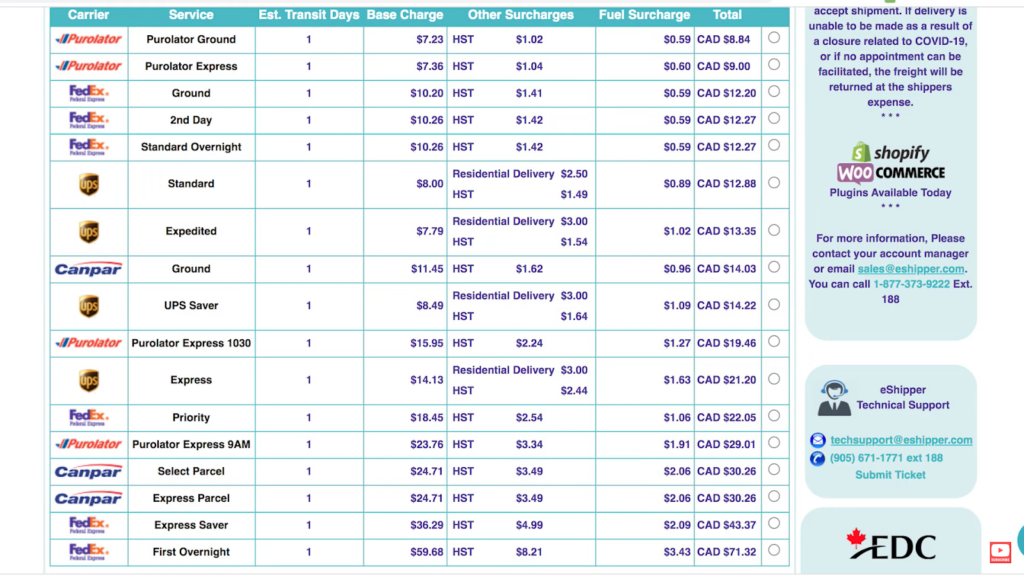
It’s marked on their end, but it comes out super cheap for any eCommerce store owners. You can have hassle-free integration with any of these stores.
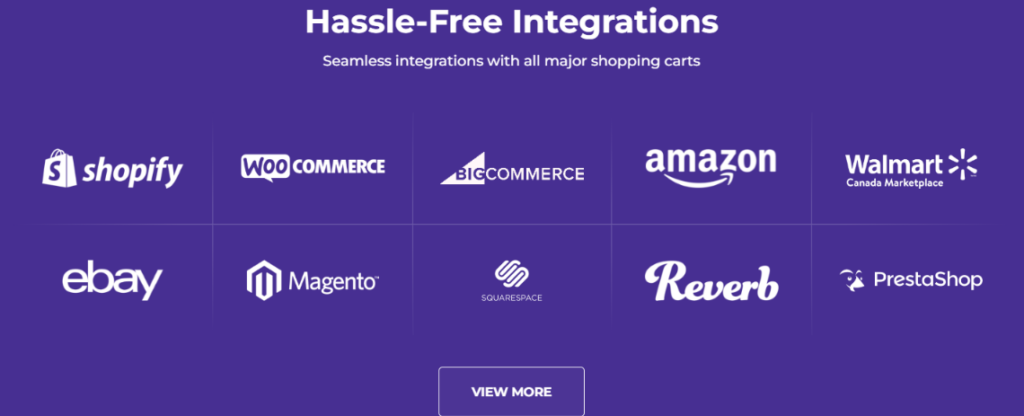
Shipping Strategy #11: Free In-Store Pickup
Free in-store shipping strategy is a bit tricky, but we like the way it increases paid shipping. Confused? We’ll demonstrate it with an example.
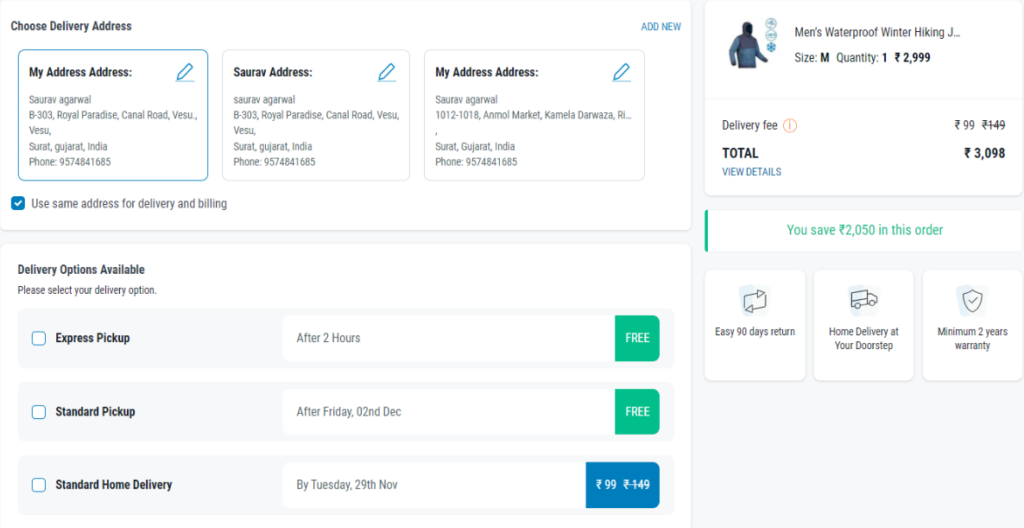
Decathlon offers express in-store pickup along with standard home delivery. In-store is obviously free. But what’s more noticeable is the placement of standard home delivery along with it. It’s not free! But it’s worth paying because “time valuation” and “fuel” may cost you more.
If you offer in-store pick up along with standard home delivery, most people will pick up standard home delivery. You did your job by offering free in-store pickup without sounding completely inconsiderate towards the customer’s shipping needs.
Shipping Strategy #12: Packing Peanuts
Packing peanuts is a weird but interesting strategy for poly mailers. So when you deliver something in poly mailers, they may get upgraded to priority mail packaging in the US. The shipping companies do it because they feel the package needs to be delivered quickly.
So one way to avoid this automatic upgradation is to put packing peanuts in the mailer. A little peanut gives it a width of about half an inch which automatically disqualifies the poly mailer from getting upgraded.

Put one of these in your poly mailers and save shipping costs by $8 to 9$.
Shipping Strategy #13: Fulfillment Partners
The last in the strategy is the fulfillment partner. When you reach the stage wherein you don’t want to take a headache for packaging and shipping, fulfillment partners knock in. A fulfillment partner is a third-party logistic provider that picks, packs, and ships on your behalf. These 3PL parties automate your shipping and save money for you. Other benefits of having fulfillment partners:
- Cheaper shipping rates
- You spend less time
- Short delivery time
But be aware they are not for everyone. You’re likely to compromise with packaging.
- First, the unboxing experience will suck.
- Second, you can’t create customized packaging.
- Third, you’ll have to get satisfied with stock boxes
- Fourth, you’ll have to pay labor and storage fees

Source: Shopify
Conclusion
That’s all with calculating shipping costs and strategies. You need to understand that no strategy or calculation is perfect. Feel free to experiment around. Don’t be afraid of challenging your shipping experiments. You can always change your strategies.
The next & final step in building an eCommerce store is launching eCommerce with strategies. We have discussed each strategy in detail, just as we did for shipping.


